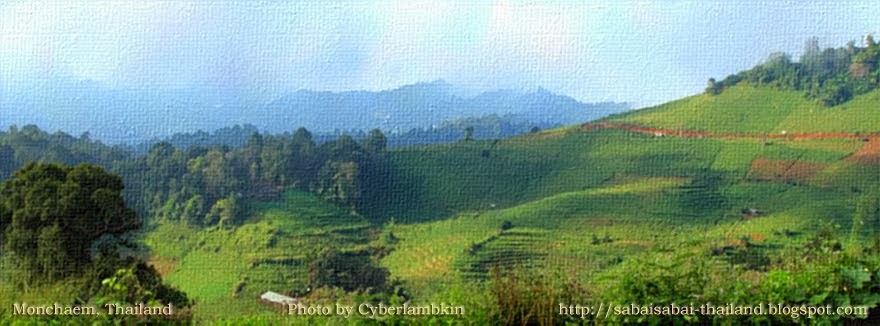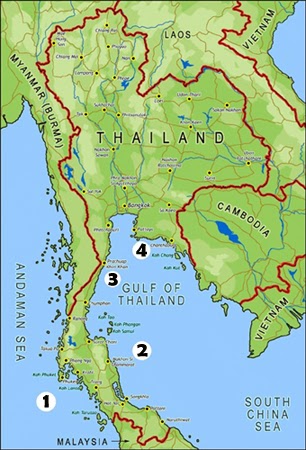The other day a foreign friend of mine called me up and said two of her cousins will be taking a holiday in Thailand and she wondered whether I can suggest anything to make their stay easier as they do not have any knowledge of the Thai language.
Well, the first thing I thought of was that they should at least be able to communicate with people on the street effectively in order to get directions to go where they want and get back to their backpacker guesthouse safely. Also they should be able to buy food and other things without using too much sign language.
I told my friend I will compile lists of useful Thai phrases for her cousins and I thought perhaps I can also share these Thai phrases with you; maybe phrases used at the airports, at shops, at bus and train stations as well as every day expressions. But first, I think these useful English / Thai expressions with English pronunciations in case you want to say them instead of pointing to them can make life easier in Thailand.
Do you speak English?
คุณพูดภาษาอังกฤษได้ไหมคะ/ครับ
Khun pood pasa unglit dai mai ka / krub
My name is _____________.
ฉัน/ผม ชื่อ________________
Chan/Pom chue__________
Can you speak more slowly?
กรุณาพูดช้ากว่านี้หน่อยค่ะ/ครับ
Garuna pood cha kwa nee noi ka/krub
Where can I find a bus stop?
ฉัน/ผมจะไปขึ้นรถประจำทางได้ที่ไหนคะ/ครับ
Chan/Pom cha pai kuen rod prajam tang dai ti nai ka/krub
Excuse me? Where can I find the train station?
ขอโทษค่ะ/ครับ สถานีรถไฟไปทางไหนคะ/ครับ
Kor tod ka/krub. Satani rodfai pai tang nai ka/krub
Excuse me? Where can I find the skytrain station?
ขอโทษค่ะ/ครับ สถานีรถไฟฟ้าไปทางไหนคะ/ครับ
Kor tod ka/krub. Satani rod faifah pai tang nai ka/krub
Excuse me? Where can I find the underground train station?
ขอโทษค่ะ/ครับ สถานีรถไฟฟ้าใต้ดินไปทางไหนคะ/ครับ
Kor tod ka/krub. Satani rod faifah tai din pai tang nai ka/krub
Can you take me to Donmuang Airport please?
ฉัน/ผมต้องการไปสนามบินดอนเมืองค่ะ/ครับ
Chan/Pom tong karn pai Sanambin Donmuang ka/krub
Can you take me to Suvarnabhumi Airport please?
ฉัน/ผมต้องการไปสนามบินสุวรรณภูมิค่ะ/ครับ
Chan/Pom tong karn pai Sanambin Suvarnabhumi ka/krub
How much does this cost?
อันนี้ราคาเท่าไรคะ/ครับ
An ni raka tao rai ka/krub
Do you take credit cards?
จะจ่ายด้วยบัตรเครดิตได้ไหมคะ/ครับ
Cha jai duay bat credit dai mai ka/krub
Where is the nearest bathroom?
ขอโทษค่ะ/ครับ ห้องน้ำอยู่ทางไหน
Kor tod ka/krub. Hong nam yu tang nai?
Can you show me on a map how to get there?
ช่วยชี้บนแผนที่ว่าฉัน/ผมจะไปที่นั่นได้อย่างไรคะ/ครับ
Chuay chee bon panti wah chan/pom ja pai ti nan dai yang rai ka/krub
Will you write that down in Thai for me?
ช่วยเขียนเป็นภาษาไทยให้ฉัน/ผมหน่อยได้ไหมคะ/ครับ
Chuay kien pen pasa thai hai Chan/Pom noi dai mai ka/krub
By the way, in Thai language the word I is translated as Chan when spoken by a female, and Pom when spoken by a male, and Thai sentences often end with ka when spoken by a female and krub when spoken by a male, so you should choose only one form when you speak.
During the next days, I’ll be sharing with you phrases which are used at the airport, at bus terminals, as well as everyday expressions.
Till then… ^^
Well, the first thing I thought of was that they should at least be able to communicate with people on the street effectively in order to get directions to go where they want and get back to their backpacker guesthouse safely. Also they should be able to buy food and other things without using too much sign language.
I told my friend I will compile lists of useful Thai phrases for her cousins and I thought perhaps I can also share these Thai phrases with you; maybe phrases used at the airports, at shops, at bus and train stations as well as every day expressions. But first, I think these useful English / Thai expressions with English pronunciations in case you want to say them instead of pointing to them can make life easier in Thailand.
Do you speak English?
คุณพูดภาษาอังกฤษได้ไหมคะ/ครับ
Khun pood pasa unglit dai mai ka / krub
My name is _____________.
ฉัน/ผม ชื่อ________________
Chan/Pom chue__________
Can you speak more slowly?
กรุณาพูดช้ากว่านี้หน่อยค่ะ/ครับ
Garuna pood cha kwa nee noi ka/krub
Where can I find a bus stop?
ฉัน/ผมจะไปขึ้นรถประจำทางได้ที่ไหนคะ/ครับ
Chan/Pom cha pai kuen rod prajam tang dai ti nai ka/krub
Excuse me? Where can I find the train station?
ขอโทษค่ะ/ครับ สถานีรถไฟไปทางไหนคะ/ครับ
Kor tod ka/krub. Satani rodfai pai tang nai ka/krub
Excuse me? Where can I find the skytrain station?
ขอโทษค่ะ/ครับ สถานีรถไฟฟ้าไปทางไหนคะ/ครับ
Kor tod ka/krub. Satani rod faifah pai tang nai ka/krub
Excuse me? Where can I find the underground train station?
ขอโทษค่ะ/ครับ สถานีรถไฟฟ้าใต้ดินไปทางไหนคะ/ครับ
Kor tod ka/krub. Satani rod faifah tai din pai tang nai ka/krub
Can you take me to Donmuang Airport please?
ฉัน/ผมต้องการไปสนามบินดอนเมืองค่ะ/ครับ
Chan/Pom tong karn pai Sanambin Donmuang ka/krub
Can you take me to Suvarnabhumi Airport please?
ฉัน/ผมต้องการไปสนามบินสุวรรณภูมิค่ะ/ครับ
Chan/Pom tong karn pai Sanambin Suvarnabhumi ka/krub
How much does this cost?
อันนี้ราคาเท่าไรคะ/ครับ
An ni raka tao rai ka/krub
Do you take credit cards?
จะจ่ายด้วยบัตรเครดิตได้ไหมคะ/ครับ
Cha jai duay bat credit dai mai ka/krub
Where is the nearest bathroom?
ขอโทษค่ะ/ครับ ห้องน้ำอยู่ทางไหน
Kor tod ka/krub. Hong nam yu tang nai?
Can you show me on a map how to get there?
ช่วยชี้บนแผนที่ว่าฉัน/ผมจะไปที่นั่นได้อย่างไรคะ/ครับ
Chuay chee bon panti wah chan/pom ja pai ti nan dai yang rai ka/krub
Will you write that down in Thai for me?
ช่วยเขียนเป็นภาษาไทยให้ฉัน/ผมหน่อยได้ไหมคะ/ครับ
Chuay kien pen pasa thai hai Chan/Pom noi dai mai ka/krub
By the way, in Thai language the word I is translated as Chan when spoken by a female, and Pom when spoken by a male, and Thai sentences often end with ka when spoken by a female and krub when spoken by a male, so you should choose only one form when you speak.
During the next days, I’ll be sharing with you phrases which are used at the airport, at bus terminals, as well as everyday expressions.
Till then… ^^




